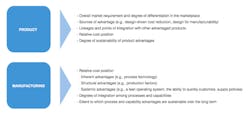How to Create Competitive Advantage: Focus on the Core
Today’s industrial giants are facing the problem of bloated manufacturing footprints. Ancillary activities added during years of global expansion have drained resources from strengths that once fueled growth, making it difficult to prioritize investments strategically.
But these companies can tackle the problem by refocusing their investments on a narrower set of activities that offer their products a competitive advantage, and de-emphasizing or outsourcing activities that don’t contribute to their competitive position.
This shifting of capital to higher-return activities will drive growth, expand margins, and set manufacturers up with a powerful strategic advantage in increasingly competitive markets.
Common Ritual
Historically, finance and operations executives have struggled to agree on investment priorities. CFOs, juggling multiple funding proposals, are conditioned to reflexively reject the COO’s initial request. COOs, knowing this, start bidding well above the amount they really need. Both sides eventually reach compromises, reflecting gamesmanship and bargaining power rather than meaningful agreement on the company’s manufacturing objectives.
This concession gridlock is the result of expansion during the last half of the 20th century, which produced many U.S. manufacturing global giants. But that growth also translated to these manufacturing behemoths losing focus on the strengths that distinguished them from one another.
These companies had invested across a wide range of activities within their manufacturing operations, for example, making significant investments in new specialized computer-based manufacturing processes, often to watch them become commodities a few years later. They then placed bets on new products that used manufacturing technologies outside their comfort zone, and saw competitors that had more familiarity with those technologies offer their products at lower prices.
These actions created ad hoc operating models that consumed capital unnecessarily, sapped returns, and made many manufacturers vulnerable to more focused rivals. Still, most manufacturers haven’t yet addressed the underlying complexity of their operations. They’ve simply added more technology without considering whether each element adds value.
Creating Advantage
The concept of “advantage” is often misunderstood in manufacturing; industry professionals sometimes perceive it as being related to either shop-floor operations or business strategy. Although both those elements are important, they are important only in the context of what makes a company distinctive: how its mix of product, process, and people enables it to produce a relevant, unique offering.
But a recent Booz & Company study shows that companies focused on core strengths are more profitable. The 2013 Fit for Growth* Index Study measured the EBIT margins and shareholder returns of leading consumer packaged goods manufacturers during a six-year period. Companies—including Kimberly-Clark, PepsiCo, Wrigley Company, and Coca-Cola—that closely aligned their way to play in the market with an integrated capabilities system and the full line of products and services experienced higher returns by both measures. Companies lacking in focus during this time frame, such as ConAgra Foods and Sara Lee, measured significantly lower.
Aligning Operations and Finance
To create focus in operations, manufacturing leaders need to ensure that the operational plan is focused on leveraging the company’s capabilities and differentiators by asking themselves, “What is it about our operations that helps make our products distinctive?” Finance leaders, in turn, must ask themselves, “Does the investment plan support our true core capabilities, or are our investment dollars focused on supporting operations that are not differentiators?” Once both sides identify what areas are noncore, they must decide how to address them, and whether they should reduce investments or outsource these operations.
It takes an informed perspective to find the right answers, and it will take courage to act on conclusions and to make the difficult choices that align shop-floor investments with a tightly defined set of competitive strengths. The reorienting of manufacturing around a chosen group of core activities will encounter opposition at many levels. Activities that are noncore may still have deep roots in the organization, and powerful defenders may resist attempts to outsource them or scale them back.
Success requires top executives to fully commit and make a sustained effort to gain input from the entire organization, dealing effectively with people’s concerns. For finance and operations leaders, striking the right balance will free up substantial capital, improve focus, and reduce cost.
Finding the Core
Setting your agenda begins with understanding what is “core” to your business. Identifying these activities requires deep knowledge of both the economics of the product and what the customer truly values.
Begin with a holistic review of the product portfolio and the supporting manufacturing operations to identify core strengths. The analysis must span both products and manufacturing processes. Examine assets, processes, and facilities to determine which support a sustainable differentiating capability, helping the company deliver on its unique value proposition. When analyzing activities, divide them into three categories: core, noncore, and situational.
Core activities are critical to the company’s bottom line, contributing directly to its value proposition in the market. They may also contribute to a feature that gives the product its distinct advantage, or they may be the source of cost advantages through process technology, scale, or location.
Noncore activities provide little or no incremental advantage to the company and yield little or no differentiation in the market. Often, other options exist for performing the process just as effectively as or more cost-effectively than the company’s own solution.
Situational activities are more difficult to identify and categorize. They fall somewhere between core and noncore, because it’s not always clear whether a protectable advantage exists or can be created for them. These activities might create a sustainable advantage for the company under certain circumstances, or they might differentiate products in specific market segments. The number of these situational activities should be few, and it’s worthwhile to objectively evaluate each and declare it core or noncore.
Learn by Example
One manufacturer of hardware building products used this approach to identify core and noncore elements in its production process for one component of the systems: steel security doors.
In the noncore category, the approach identified activities such as assembly and painting that could be outsourced without compromising a competitive advantage. In the situational category, the approach showed that the uncoiling and cutting of sheet metal for the doors weren’t core strengths, but were so tightly linked to the core activity of metal bending that those activities probably could not be outsourced.
As for the core, interestingly, only bending of metal turned out to be a truly core capability, owing to the complexity associated with trouble-free programming of the bending equipment. The whole exercise had shown the company that there was little about manufacturing security doors that was actually core.
After leaders worked with sales and marketing, however, it became clear that the role of the final product itself was core. The doors weren’t competitively advantaged; the important thing was having a product that could be specified together with the higher-margin security hardware. With this new information, the company scrapped many of the capital requests related to expensive metal bending equipment packages in favor of devoting more marketing and investment dollars to the combined door and hardware offering.
Worth the Battle
Any manufacturer can reap the benefits of a core versus noncore manufacturing agenda by determining which of its many activities underpin a key competitive advantage, and focusing its investments, resources, and management attention on those areas.
For many companies, it’s high time for finance and operations to join forces to recapture the focus on core strengths. Shedding or de-emphasizing noncore activities will free up capital, cash, and talent for the activities that support a company’s differentiating capabilities and create unique value in the marketplace. But making those needed changes will take leadership and perspective on what really matters.
It can be done, with a little bit of courage and perspective. Given the potential upside, it’s a battle well worth fighting.
Al Kent is a Florham Park-based Partner at Strategy& focused on cost reduction topics within the Industrials, Chemicals and Energy industries.
Based in Strategy&’s Chicago office, Partner Eric Dustman is aligned with the Operations and EPS practices.
Arvind Kaushal is a Chicago based Partner at Strategy& focused on manufacturing strategy and Fit for Growth operations transformations in the Industrials and Automotive industries.
*Fit for Growth is a registered service mark of Booz & Company Inc. in the United States.






